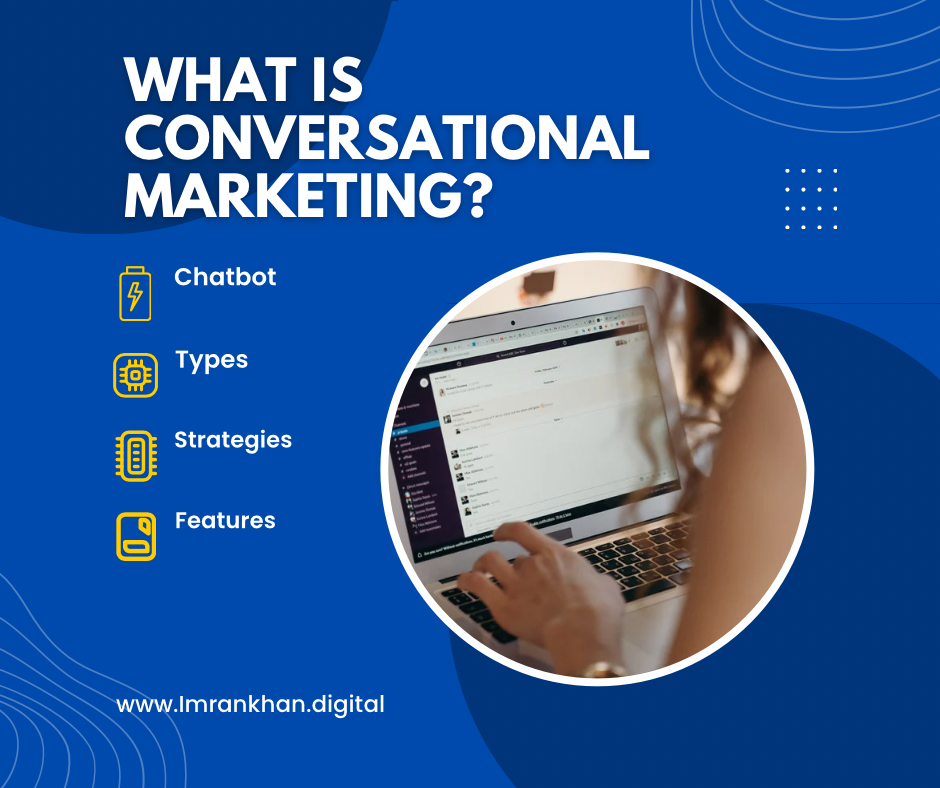
Conversational marketing is a great approach to engage customers continuously. By taking advantage of conversational interactions such as voice and messaging through platforms like SMS, WhatsApp, and live chat, customers feel noticed, listened to, and respected. Nowadays, chatbots are crucial for conversational marketing to build closer relationships with customers and give them a unique, custom-made experience.
All You Need To Know About Conversational Marketing
Conversational marketing centers around meaningful interactions with customers in real-time dialogues. Rather than a one-way message, two-way communications let marketers better understand customer preferences, needs and goals, and allow for customer feedback that enables marketers to make decisions tailored to the individual customer.
This approach to marketing focuses on customer engagement through an exchange of meaningful conversations.
What are Chatbots?
Chatbots offer a unique solution to providing personalized, automated assistance. Powered by AI and machine learning, they are programmed to interact with users naturally, understanding the intent behind user requests. This capability allows them to offer users an effortless way to get their desired information, saving time and increasing efficiency.
Beyond this, chatbots are also capable of more sophisticated tasks such as payment processing and form filling. Ultimately, chatbots offer a faster, smoother user experience and greater customer satisfaction.
Types of Chatbots
Chatbots come in many different forms and can serve a variety of different functions. There are four main types of chatbots, each providing a unique and important function. These are Conversational bots, Decision tree bots, Recommendation bots, and Virtual Assistant bots.
Conversational bots are typically used in customer service to engage customers and quickly answer simple inquiries.
Decision tree bots are best suited to providing a multiple choice style of conversational flow, while Recommendation bots can assist in recommending the right products or services to customers.
Finally, Virtual Assistant bots are typically used for more complex tasks and activities. They often use AI technology to interact with customers in more personalized ways.
How does conversational marketing work?
Conversational marketing is an innovative customer experience strategy that helps brands foster meaningful relationships with customers by engaging in personalized, natural conversations over messaging and chat. It enables brands to leverage automated, AI-driven chatbots and other conversational marketing tools to automate lead generation and qualify sales opportunities.
This enables brands to not only create better customer experiences but also build trust with potential customers through human-like conversations that feel natural. By having conversations over chat instead of traditional methods, brands are able to build deeper connections with customers while gathering invaluable customer feedback in order to better meet their needs. Ultimately, conversational marketing can lead to greater customer satisfaction and higher conversions.
What are the pillars of conversational marketing?
Pillars of Conversational Marketing
1. Data and Personalization:
Collecting data about your customers’ needs, preferences and behaviors is key to delivering personalized conversations that resonate.
2. Technology:
Deploying the right technology is essential to scale one-to-one conversations and offer real-time experiences.
3. Engagement:
Initiating conversations and fostering meaningful interactions is necessary for businesses to effectively engage their customers.
4. Quality:
Maintaining a high level of quality and reliability in conversations and conversation interactions ensures a better customer experience.
5. Content:
Delivering relevant and timely content at the right time helps ensure the success of a conversational marketing strategy.
How to leverage conversational marketing in businesses?
Conversational Marketing: Leveraging Businesses
1. Analyzing Conversational Touchpoints
– Examine customer interactions to better understand what type of conversational experience customers are expecting.
– Develop a comprehensive customer journey map that takes into account conversations at each step of the buying process.
– Identify all possible opportunities to start a conversation and improve customer relationships.
2. Setting Up a Comprehensive Chatbot Strategy
– Establish customer expectations by clearly defining what your chatbot will and will not do.
– Focus on customer convenience and deliver customer experience throughout the customer journey.
– Use personalized messages to maximize user engagement.
3. Integrating Channels
– Implement omnichannel customer service strategies.
– Connect customers with customer service reps when necessary.
– Utilize customer feedback to continuously improve services and develop new ideas.
4. Integrating Conversational Tools
– Make use of customer data to offer personalized messages and experiences.
– Use conversational marketing tools to simplify communication between customers and reps.
– Leverage conversational analytics to measure customer feedback and performance of your strategies.
5. Utilizing Social Messaging
– Increase customer reach through the use of popular messaging apps and platforms.
– Improve customer engagement by providing timely customer support and meaningful interactions.
– Gain valuable customer insights by gathering customer data from various channels.
6. Offering Self-Service
– Design a knowledge base that provides clear instructions and helps customers solve common problems on their own.
– Utilize customer feedback to constantly update and improve self-service options.
– Offer virtual assistant tools and AI technology to quickly and accurately address customer queries.
Why Companies Should Use Conversational Marketing?
Advantages of Conversational Marketing
• Easy and Convenient Communication: Conversational marketing provides customers with an easy and convenient way to communicate with a business. By having a chatbot or live agent available for customer inquiries, customers can get quick responses and have all of their questions answered without having to wait for a reply from a company representative.
• Increased Sales Opportunities: Conversational marketing can help businesses increase sales opportunities. By engaging customers through conversations, businesses can better understand their customer needs and develop personalized offers that match their interests. This helps create more positive experiences for customers, which leads to greater loyalty and more sales.
• Higher Brand Engagement: When customers have the opportunity to have conversations with a company’s brand, they tend to be more engaged with the company and its offerings. This higher level of engagement can result in higher conversion rates, more referrals, and improved customer retention.
• Cost-Effective Solutions: Conversational marketing provides companies with a cost-effective way to interact with customers. By utilizing a chatbot or live agent, businesses can reduce the time and money spent on customer service.
• Better Insights: Companies can use conversational marketing to gain valuable insights into their customers. By analyzing customer conversations, businesses can identify patterns, develop new strategies, and make better decisions to optimize customer experience and improve marketing performance.
What are the features in conversational marketing?
FEATURES OF CONVERSATIONAL MARKETING
1. Automation: Automated customer service can help businesses streamline conversations with their customers. This eliminates the need for manually answering questions and allows businesses to quickly answer customer inquiries.
2. Personalization: Conversational marketing allows businesses to provide personalized experiences to their customers. By using the right data, businesses can create tailored conversations that customers will be more likely to engage in.
3. Audience segmentation: Through segmentation, businesses can personalize conversations to cater to specific audiences. By targeting certain demographics, businesses can better tailor their conversations to different segments.
4. Omni-channel experience: With conversational marketing, businesses can provide an omnichannel experience that is personalized across channels. This helps ensure that the conversations are consistent and enjoyable for the customers regardless of which platform they use.
5. Real-time analytics: Real-time analytics help businesses analyze customer conversations to uncover patterns and optimize future conversations. By utilizing this data, businesses can ensure that conversations remain effective.
6. AI integration: Artificial intelligence can be used to create more personalized conversations. AI can analyze customer data to help determine customer preferences, enabling businesses to provide a more accurate and engaging customer experience.
What are the types of conversational marketing?
Types of Conversational Marketing
1. Chatbot:
A chatbot is a computer program or an artificial intelligence (AI) which conducts a conversation via auditory or textual methods. Chatbots are used in various marketing channels such as websites, social media platforms, and instant messaging services.
2. Live Chat:
Live chat is a type of conversational marketing where real agents communicate directly with customers. It provides an engaging and personalized experience for customers by helping them resolve issues, answer queries and process orders.
3. Video Chats:
Video chats are a type of conversational marketing that combines visual and audio elements for better engagement and enhanced customer service. Through video chats, businesses can make their services and products more accessible to customers.
4. Social Media Messenger Apps:
Social media messenger apps are an important part of conversational marketing as they provide a more direct way of engaging with customers. Through messenger apps, customers can reach businesses easily, discuss their problems and concerns, and receive personalized customer service.
5. Voice Chatbots:
Voice chatbots are becoming increasingly popular in conversational marketing. This type of technology leverages natural language processing to converse with customers in real-time, without any human intervention. It enables businesses to handle a larger number of customers, save time, and enhance customer experience.
What is a conversational marketing platform?
A conversational marketing platform is basically an AI-powered system that helps businesses improve customer interactions and build deeper relationships with their clients. It combines elements of digital marketing and chatbot technology to help businesses provide automated conversations that respond to customer inquiries.
It also provides personalized experiences, and even generates leads. Through the use of data-driven insights, it enables businesses to customize their conversations with customers in order to make the most out of each customer engagement.
With the use of automated workflows and communication, the platform can be used to create a seamless and efficient customer experience, enabling businesses to establish trust with their customers and build stronger customer relationships.
What is the role of artificial intelligence (AI) in conversational marketing?
The role of Artificial Intelligence (AI) in conversational marketing is to improve customer engagement and interactions with customers. AI can help brands reach customers through personalized and contextual conversations by leveraging customer data and analytics.
AI-powered chatbots can offer automated and customized interactions to customers in various scenarios such as sales inquiries, product research, purchase assistance, or even customer service. By leveraging AI, marketers can gain insights into customer behavior, anticipate needs and recommend relevant products or services to meet their requirements.
AI also provides a more personalised and proactive experience to customers by offering natural language processing to identify intent and sentiment and personalise the experience based on the user’s context. AI-driven conversational marketing allows marketers to not only engage customers but also optimise marketing spend through increased conversions.
How to implement conversational marketing?
Step 1: Understand Your Audience:
– Gather demographic and psychographic information
– Analyze customer buying habits.
– Use surveys and market research.
Step 2: Determine Your Messaging:
– Brainstorm different marketing campaigns.
– Develop clear messaging.
– Personalize content.
Step 3: Create Channels of Communication:
– Select appropriate platforms (e.g., social media, chatbots).
– Utilize communication tools (e.g., SMS, email, live chat).
– Customize communication settings.
Step 4: Monitor Results and Engage:
– Analyze data for effectiveness.
– Make changes to messaging and communication settings as needed.
– Respond promptly to customers.
– Engage with customers in meaningful conversations
Step 5: Leverage Your Network:
– Use referral networks.
– Foster relationships with influencers.
– Make use of online tools (e.g. CRM software) to measure effectiveness.
– Leverage customer feedback.
How to get a chatbot for your business?
Here is a guide on how to get a chatbot for your business:
I. Introduction
- Briefly explain what a chatbot is and how it can benefit your business.
- Mention the importance of choosing the right chatbot name.
II. Choosing a Conversational Chatbot Name
- Choose a name that reflects your brand’s personality.
- Avoid names that are difficult to pronounce or spell.
- Consider using a name that relates to the purpose of your chatbot.
- Brainstorm several options and get feedback from others before making a final decision.
III. Determine Your Chatbot’s Purpose and Features
- Decide what tasks you want your chatbot to accomplish.
- Identify the most common questions or issues your customers face.
- Consider integrating your chatbot with other systems or platforms (e.g., social media, CRM software).
IV. Choose a Chatbot Platform
- Research different chatbot platforms and compare their features and pricing.
- Consider the level of customization and control you want over your chatbot.
- Look for a platform that offers easy integration with your existing systems.
V. Design Your Chatbot’s Conversation Flow
- Determine the different types of messages your chatbot will send (e.g., welcome message, error message, confirmation message).
- Create a conversation flow that guides users to the information or help they need.
- Write clear and concise messages that are easy to understand.
VI. Test Your Chatbot
- Test your chatbot with a small group of users to identify and fix any issues.
- Continuously monitor your chatbot’s performance and make adjustments as needed.
VII. Launch Your Chatbot
- Promote your chatbot to your customers and provide clear instructions on how to use it.
- Monitor feedback and make improvements based on user feedback.
Some potential conversational chatbot names could include:
- Lucy
- Atlas
- Ava
- Felix
- Max
- Lily
- Kora
- Milo
- Zoe
- Orion
Remember to choose a name that aligns with your brand’s personality and purpose!
Conversational Marketing Strategies
• Using Chatbots
Chatbots are a great way to add a conversational element to marketing campaigns. Chatbots are programmed with natural language processing and can carry out conversations with customers or potential customers. They are an efficient way to answer frequently asked questions and handle customer service requests.
• Text Messages
Text messages can be used to directly engage customers and start a conversation. Messages should be relevant, timely and offer something of value such as a discount code or special offer.
• Live Chat
Live chat on a website or in an app allows customers to ask questions and have real-time conversations with customer service representatives. This type of direct interaction can provide quick answers and create a better customer experience.
• Social Media
Social media can be used to start conversations with customers and engage them in conversation about their experiences. Social media also allows for an easy exchange of ideas and opinions that can be valuable in developing more effective marketing strategies.
• Video Conferencing
Video conferencing is another way to create a conversational experience. Customers can interact directly with a representative and have their questions answered in real-time. This type of conversation allows for more detailed responses and a more meaningful connection with the customer.
Examples of Conversational Marketing
1. Live Chat
Live chat involves a company having customer service representatives available on their website for people to chat with. The customer service reps are able to answer customer questions in real time and can help customers purchase a product or service.
2. Text Message Conversations
Text message conversations between a business and their customer are becoming increasingly popular. Businesses can send automated text messages that respond to customers’ inquiries or let them know about new products or services.
3. Chatbots
Chatbots are automated programs that can simulate a conversation with a human user. They are able to answer basic customer questions and provide customer support.
4. Social Media Messaging
Social media messaging is a form of conversational marketing where businesses can directly interact with their customers through messaging platforms such as Facebook Messenger, Twitter DM’s, or Instagram Direct Messages.
5. Video Conferencing
Video conferencing is another great way to have real-time conversations with customers. Businesses can provide personalized one-on-one consultations and offer their services in an engaging and personal way.
Benefits of Conversational Marketing
1. Increased Customer Engagement:
Conversational marketing tools provide a more direct, humanized way for customers to interact with brands. With a friendly chatbot or live agent available, customers can easily get quick answers to their questions, leading to more successful interactions and an increased overall satisfaction.
2. Improved Customer Insights:
By using conversational marketing tools, companies can better understand their customers and gain useful insights about them. These tools collect data about customer behaviors and interests, allowing for more effective campaigns and more personalized services.
3. Enhanced Customer Support:
With conversational marketing, customers can access help in a quick and convenient way. They can get their issues resolved with less effort and frustration, resulting in more satisfied customers.
4. Increased Revenue:
Through increased customer engagement, better customer insights, and improved customer support, conversational marketing can ultimately lead to more sales. The data gathered can be used to tailor campaigns to customers and create more efficient services, thus boosting sales.
5. Faster Response Time:
The use of conversational marketing tools allows companies to respond to customers almost instantaneously, leading to a much faster response time. This helps brands remain competitive and establishes a higher level of trust with their customers.
Final Words
Conversational marketing is a great way for businesses to engage with customers, increase sales opportunities, improve customer retention, and gain better insights into their customers. It is also a cost-effective solution for companies to provide efficient customer service. With all of these advantages, it’s no wonder why more and more companies are turning to conversational marketing.





